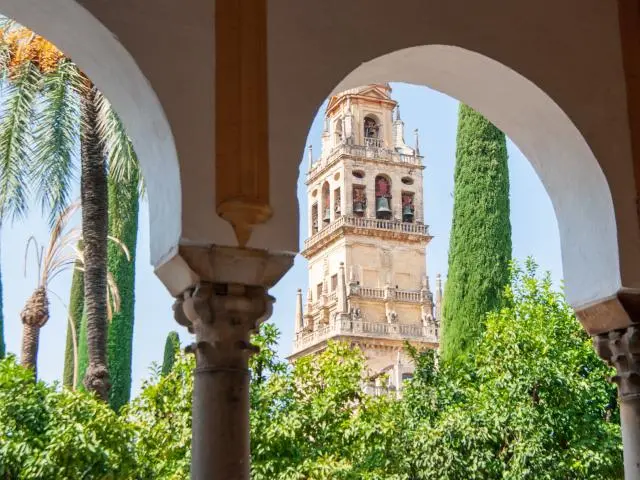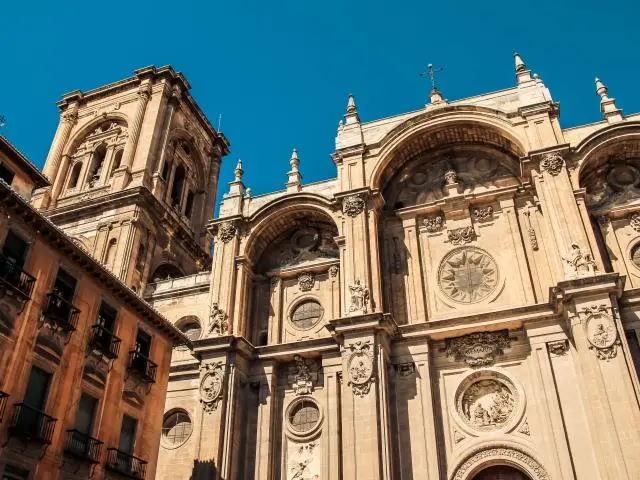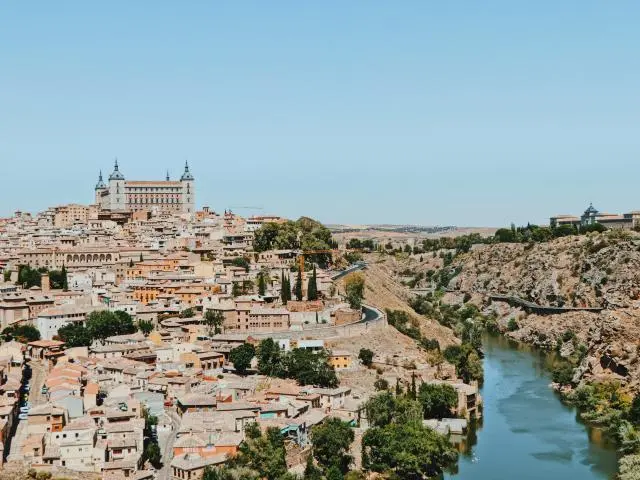Day 1 Lisbon - Caceres - Seville (524 km)
Day 2 Seville
Day 3 Seville - Cordoba (119 km)
Day 4 Cordoba - Ronda - Costa del Sol (194 km)
Day 5 Costa del Sol - Tangier - Fez (511 km)
Day 6 Fez
Day 7 Fez - Rabat - Tangier (393 km)
Day 8 Tangier - Costa del Sol (118 km)
Day 9 Costa del Sol - Granada (147 km)
Day 10 Granada - Toledo - Madrid (433 km)
Day 11 Madrid
Day 12 Madrid - Trujillo - Lisbon (623 km)
Day 1:
Lisbon - Caceres - Seville (524 km)
Breakfast: Excluded|Lunch: Excluded|Dinner: Included
In the morning, we will depart from Lisbon and drive across the border into Spain until we reach Caceres, a UNESCO World Heritage Site, where we will spend some time exploring. Afterwards, we will continue to Sevilla, where we will enjoy dinner and spend the night.
-
Caceres, SPAIN
Caceres is the capital of Caceres province, in the autonomous community of Extremadura, Spain. The municipio has a land area of 1,750.33 km2 (675.81 sq mi), the largest geographically in Spain. The walled city has been declared a UNESCO World Heritage Site.
Day 2:
Seville
Breakfast: Included|Lunch: Excluded|Dinner: Excluded
We will tour Seville in the morning, visiting the Parque de Maria Luisa, the Plaza de Espana, the exterior of the city’s stunning Cathedral and its bell tower, called Giralda and the typical neighbourhood of Santa Cruz with its streets, squares and narrow alleys. If you wish, you can optionally navigate the Guadalquivir river, during which you will enjoy a panoramic view of the Gold Tower and Expo 92, or visit to the Maestranza bullring. In the evening, also as an op- tional activity, you can attend a flamenco show.
-
Seville, SPAIN
Seville is the capital of Andalucia and the cultural and financial centre of southern Spain. A city of just over 700,000 inhabitants (1.6 million in the metropolitan area, making it Spain's 4th largest city), Seville is Andalucia's top destination, with much to offer the traveler.
Parque de Maria Luisa
On the riverbanks of Sevilla, Maria Luisa Park is a large public area that features lovely foliage, fountains, and walkways in the middle of this beautiful city. Within the park are many statues of famous Spanish figures.
Plaza de Espana
A large section of Maria Luisa Park in Sevilla, the Plaza de Espana is a large open space featuring buildings of Renaissance revival architecture. Most of the buildings are currently used for government purposes.
La Giralda
La Giralda was once a minaret for the Muslim population in medieval Sevilla, but was converted to a church bell tower after Christian forces had regained power in Iberia. Its design has influenced many other towers around the world.
Santa Cruz (Jewish Quarter)
The barrio of Santa Cruz in Sevilla was once the city's Jewish Quarter, and is now the most popular tourist are in the city. The narrow, winding streets and alleyways of this neighborhood remind visitors of a labyrinth.
Day 3:
Seville - Cordoba (119 km)
Breakfast: Included|Lunch: Excluded|Dinner: Included
In the morning, we will head to Cordoba, visiting the Mosque-Cathedral, the Jewish Quarter, and more. Then, we will have the rest of the day free to spend at our own leisure.
-
Cordoba, SPAIN
Cordoba is a city in Andalusia, Spain, and the capital of the province of Cordoba. The city is located on the banks of the Guadalquivir river, and its easy access to the mining resources of the Sierra Morena satisfies the population's needs.
The Mosque-Cathedral of Cordoba
The interior of this dual mosque-cathedral perfectly reflects the religious power-struggle of medieval Spain. The conversion of the church into a mosque lasted from 784 to 987. The complex is massive and features many small chapels.
Jewish Quarter
Cordoba's Jewish Quarter is marked by narrow and irregular streets. It houses a medieval Synagogue and the Sephardic House. Unfortunately, this neighborhood was a focal point of the Spanish Inquisition, during which Cordoba played a large role.
Day 4:
Cordoba - Ronda - Costa del Sol (194 km)
Breakfast: Included|Lunch: Excluded|Dinner: Included
On our way to Costa del Sol, we will stop in the village of Ronda to see the famous Puento Nuevo Bridge. After some free time here, we will continue to the Costa del Sol, where we will eat dinner and spend the night.
-
Ronda, SPAIN
Ronda is a city in the Spanish province of Malaga. It is located about 100 kilometres (62 mi) west of the city of Malaga, within the autonomous community of Andalusia.
Puente Nuevo Bridge
This 18th century bridge crosses a 390-foot deep ravine that divides the small Andalusian city of Ronda. There is a central chamber underneath the bridge's walkway that today houses a small exhibit about the bridge's history.
-
Costa del Sol, SPAIN
It is a region in the south of Spain, in the autonomous community of Andalusia, comprising the coastal towns and communities along the coastline of the Province of Malaga. Formerly made up only of a series of small fishing settlements, today the region is a world-renowned tourist destination.
Day 5:
Costa del Sol - Tangier - Fez (511 km)
Breakfast: Included|Lunch: Excluded|Dinner: Included
After breakfast, we will board a ferry on the southern coast of Spain that will carry us across the Bay of Gibraltar to Morocco. Once there, we will disembark and continue on a bus to the city of Tangier, where we will take a sightseeing tour before continuing to Fez for the night.
-
Costa del Sol, SPAIN
It is a region in the south of Spain, in the autonomous community of Andalusia, comprising the coastal towns and communities along the coastline of the Province of Malaga. Formerly made up only of a series of small fishing settlements, today the region is a world-renowned tourist destination.
-
Tangier, Morocco
Tangier is a major city in northern Morocco. The history of Tangier is very rich, due to the historical presence of many civilizations and cultures starting from before the 5th century BCE.
Day 6:
Fez
Breakfast: Included|Lunch: Included|Dinner: Excluded
After breakfast, we will start with a panoramic tour from the hotel to visit the royal palace and its 7 gates or Dar Al-Makhzen on the way to the fascinating world of the medina of Fez El Bali. From Bab Boujloud to Es-Seffarine square we will make a journey through the centuries starting in the 9th to the 19th century, along the walk we will know how these alleys are structured, the different constructions that make up the walls of the medina, in addition from its artisan guilds and neighborhoods such as leather tanners or seamstresses to see their old ways of working. We will know a Medersa and we will finish to the sound of the hammer of the potters working the copper as they did hundreds of years ago. Lunch in a typical restaurant. In the afternoon we recommend taking an extra excursion to Meknés.
-
Fez, Morocco
The third-largest city in Morocco, Fez features beautiful historic architecture that showcases the incredible works of the Arab world.
Fes el Bali
The Fes el Bali is one of two medina quarters in the city of Fes, Morocco and a UNESCO World Heritage site. The district is surrounded by historic walls, and features excellent examples of Arab Moroccan art and architecture.
Royal Palace gate
It is the royal palace of the Sultan of Alaouite in Fez, Morocco. The palace is located in the Fez Jdid district. It is 80 hectares in size and is known for its brass doors decorated with hard tiles and carved cedarwood. The palace is not open to the public.
Day 7:
Fez - Rabat - Tangier (393 km)
Breakfast: Included|Lunch: Excluded|Dinner: Included
Today, we will eat breakfast and depart to Rabat, the nation's capital, where we will visit the Mausoleum of Mohamed and Hassan Tower. Afterward, we will go to Tangier for the night.
-
Rabat, Morocco
Rabat is the capital and fourth largest city of Morocco. Tourism and the presence of all foreign embassies in Morocco serve to make Rabat one of the most important cities in the country.
Mausoleum of Mohammed V
This mausoleum in Rabat is the burial site of King Mohammed V, who was king of the country until his death in 1961. The mausoleum is considered a beautiful example of the architectural style of the Alaouite Dynasty.
Hassan Tower
The Hassan Tower is all that remains of an incomplete mosque, built in the 12th century AD, that was intended to be the world's largest. The Tower is only half as high as originally intended.
Day 8:
Tangier - Costa del Sol (118 km)
Breakfast: Included|Lunch: Excluded|Dinner: Included
After breakfast, we will board the ferry and return to Costa del Sol, where we will enjoy dinner and settle into our hotel accommodations for the night.
-
Costa del Sol, SPAIN
It is a region in the south of Spain, in the autonomous community of Andalusia, comprising the coastal towns and communities along the coastline of the Province of Malaga. Formerly made up only of a series of small fishing settlements, today the region is a world-renowned tourist destination.
Day 9:
Costa del Sol - Granada (147 km)
Breakfast: Included|Lunch: Excluded|Dinner: Included
After breakfast, we will drive to Granada, where we will visit the Alhambra, the massive fortress complex built by the former Arab rulers of southern Spain. We may also take an optional trip to the Caves of Sacramonte and see a special flamenco show.
-
Granada, SPAIN
Granada is a mid-sized provincial capital in the Andalucia region of Spain. Rich in history and culture, Granada is arguably the single most worthwhile city in Spain for visitors. Spring and autumn are also both excellent times to visit.
Alhambra
The Alhambra is a massive complex consisting of multiple palaces and fortresses. It originated as a Spanish-Muslim fortress in the 9th century, but subsequent rulers, both Muslim and Christian, continually added additions and renovations.
Caves of Sacromonte
The soft rocks on the hillsides in the Granada neighborhood of Sacromonte were carved into cave-dwellings by the nomadic Gitano people in the area in the 19th century, many of whom still inhabit these caves.
Day 10:
Granada - Toledo - Madrid (433 km)
Breakfast: Included|Lunch: Included|Dinner: Excluded
We will depart Granada for the imperial city of Toledo, the crossroads of medieval Christianity, Judaism, and Islam. After lunch, we will enjoy a sightseeing tour among the city's narrow streets. Afterwards, we will return to Madrid, arriving in the late afternoon or early evening.
-
Toledo, SPAIN
Toledo is known as the "Imperial City" for having been the main venue of the court of Charles I, and as the "City of the Three Cultures", having been influenced by a historical co-existence of Christians, Muslims and Jews.
Day 11:
Madrid
Breakfast: Included|Lunch: Excluded|Dinner: Excluded
After breakfast, we will visit some of the most iconic sites in Madrid, including the Gran Via, Plaza de Oriente, the Fountain of Cibeles, Columbus Square, Plaza de Espana, Puerta de Alcala, Paseo de la Castellana, and more. In the late afternoon, guests can continue exploring the city on their own.
-
Madrid, SPAIN
Madrid is both the capital of Spain and its largest city. A modern city with a historic architecture where you can visit the Royal Palace, Prado Museum, Bernabeu Stadium, Fountain of Cibeles and more.
Gran Via
The Gran Via, oftentimes referred to as "The Spanish Broadway," is a central avenue in Madrid with some of the finest shops in the city, not to mention one of the most active nightlife scenes of any European city.
Plaza de Espana
This large public square in Madrid features a huge monument to Miguel de Cervantes, Spain's most widely-read writer, that hovers over bronze sculptures of Cervantes' two iconic characters, Don Quixote and Sancho Panza.
Fountain of Cibeles
The centerpiece of the plaza that bears the same name, the Fountain of Cibeles features a statue of an ancient Phrygian goddess sitting atop a lion-drawn chariot, who has been adopted as a symbol of the city of Madrid.
Columbus Square
Columbus Square in Madrid is dedicated to the explorer Christopher Columbus, whose statue stands on a tall monument high above. The plaza features a second monument with quotes by philosophers and famous Spanish leaders and the Gardens of Discovery.
Puerta de Alcala
This monument is designed in the neo-Classical style, and stands near Madrid's city center, reminiscent of the old medieval gates to the city, although this gate stands alone.
Paseo de la Castellana
La Castellana is a wide avenue that cuts North-to-South through the very center of Madrid, one of the city's busiest streets, and home to some of its most famous buildings including the Puerta de Europa and the Santiago Bernabeu stadium.
Day 12:
Madrid - Trujillo - Lisbon (623 km)
Breakfast: Included|Lunch: Excluded|Dinner: Excluded
In the morning, we will depart for the city of Trujillo, where we will have some free time to explore and see the Plaza Mayor. Afterwards, we will cross the Portuguese border on our way to Lisbon, where the tour will come to an end. Please see "Departure and Return" for more detailed information regarding pickup and drop-off times and locations.
-
Trujillo, SPAIN
Trujillo is a municipality located in the province of Caceres, in the autonomous community of Extremadura, Spain. Trujillo is both a centre for tourism, with over 25 hotels, and a regional market town.
Plaza Mayor
The Plaza Mayor in Trujillo is unique because of its uneven and irregular design. It is surrounded by buildings dating from around the 16th century. The Church of Santa Maria is a 13th century building that towers over the square.






 10-Day Andalusia & Morocco Tour from Madrid...
10-Day Andalusia & Morocco Tour from Madrid...
 13-Day Portugal, Andalusia & Morocco Tour from Madrid...
13-Day Portugal, Andalusia & Morocco Tour from Madrid...
 16-Day Portugal, Andalusia & Morocco Tour from Madrid...
16-Day Portugal, Andalusia & Morocco Tour from Madrid...
 12-Day Andalucia and Morocco Tour from Lisbon...
12-Day Andalucia and Morocco Tour from Lisbon...
 10-Day Andalucia and Morocco Tour from Lisbon...
10-Day Andalucia and Morocco Tour from Lisbon...